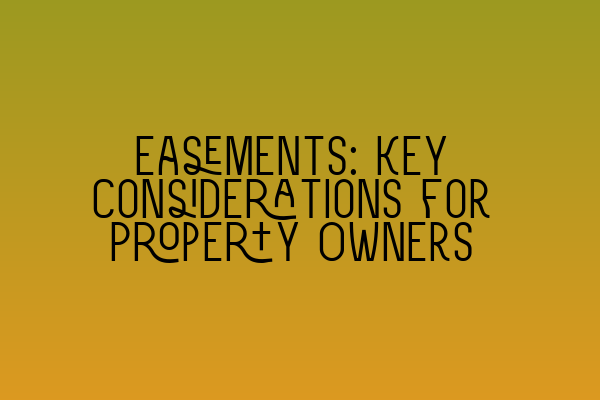Easements: Key Considerations for Property Owners
When it comes to property ownership, there are various rights and responsibilities that homeowners need to understand. One important concept to grasp is easements. In this article, we will delve into easements and discuss the key considerations that property owners should keep in mind.
What is an Easement?
An easement is a legal right that allows someone to use another person’s property for a particular purpose. It is a nonpossessory interest in the land that grants specific access or use rights to the easement holder, while the property owner retains ownership and control of the land.
Easements can come in different forms, including:
- Appurtenant Easement: This type of easement benefits the dominant estate (the property that benefits from the right) and burdens the servient estate (the property that is subject to the easement).
- In Gross Easement: In this case, the easement is attached to the individual or entity rather than the land itself.
- Prescriptive Easement: A prescriptive easement arises when someone openly and continuously uses another person’s property without permission for a certain period and meets specific legal requirements.
Key Considerations for Property Owners:
1. Understanding Existing Easements:
Before purchasing a property, it is crucial to have a comprehensive understanding of any existing easements associated with the land. This can be accomplished by reviewing the property’s title report and conducting a thorough due diligence process.
By knowing the existing easements, property owners can determine the extent of their rights and obligations and plan accordingly. For example, if there is an easement allowing utility companies to access certain areas of the property, owners can ensure they do not obstruct these areas when making future improvements or constructions.
2. Granting Easements:
Property owners may consider granting an easement to provide access or use rights to others. This decision should be made after careful consideration of the potential impact on their property and future plans.
When granting easements, property owners should consult with legal professionals to ensure that the easement meets their intentions and protects their rights. Proper documentation, such as an easement agreement, should be drafted to clearly outline the terms and conditions of the easement.
3. Resolving Easement Disputes:
Easement disputes can arise between property owners and easement holders, often concerning issues related to the scope of use or maintenance responsibilities.
If a dispute arises, property owners should seek legal advice to understand their rights and obligations. Mediation or negotiation may be explored as alternative dispute resolution methods to avoid costly and time-consuming litigation.
4. Modifying or Terminating Easements:
In certain situations, property owners may wish to modify or terminate an existing easement. However, this process can be complex and requires legal expertise.
Property owners should carefully assess their reasons for wanting to modify or terminate an easement and consult with solicitors knowledgeable in property law. Valid reasons for modification or termination might include changes in land use, no longer needing the easement, or proving that the easement is no longer necessary or burdensome.
Conclusion
Easements are a crucial aspect of property ownership that can have a significant impact on a homeowner’s rights and responsibilities. Understanding existing easements, granting easements, resolving disputes, and potentially modifying or terminating easements are all key considerations for property owners.
By familiarizing themselves with the intricacies of easements and working with experienced solicitors, property owners can navigate the complexities of easement law and protect their interests.
Related Articles:
